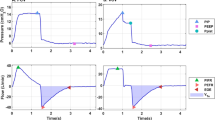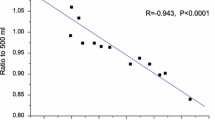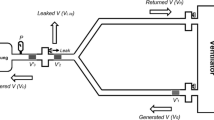Abstract
Volatile anesthetics alter the physical properties of inhaled gases, such as density and viscosity. We hypothesized that the use of these agents during mechanical ventilation would yield systematic biases in estimates of flow (\(\dot{V}\)) and tidal volume (V T) for two commonly used flowmeters: the pneumotachograph (PNT), which measures a differential pressure across a calibrated resistive element, and the hot-wire anemometer (HWA), which operates based on convective heat transfer from a current-carrying wire to a flowing gas. We measured \(\dot{V}\) during ventilation of a spring-loaded mechanical test lung, using both the PNT and HWA placed in series at the airway opening. Delivered V T was estimated from the numerically-integrated \(\dot{V}\). Measurements were acquired under baseline conditions with room air, and during ventilation with increasing concentrations of isoflurane, sevoflurane, and desflurane. We also evaluated a simple compensation technique for HWA flow, which accounted for changes in gas mixture density. We found that discrepancies in estimated V T between the PNT and HWA occurred during ventilation with isoflurane (6.3 ± 3.0%), sevoflurane (10.0 ± 7.3%), and desflurane (25.8 ± 17.2%) compared to baseline conditions. The magnitude of these discrepancies increased with anesthetic concentration. A simple compensation factor based on density reduced observed differences between the flowmeters, regardless of the anesthetic or concentration. These data indicate that the choice and concentration of anesthetic agents are primary factors for differences in estimated V T between the PNT and HWA. Such discrepancies may be compensated by accounting for alterations in gas density.




Similar content being viewed by others
References
Schena E, Lupi G, Cecchini S, Silvestri S. Linearity dependence on oxygen fraction and gas temperature of a novel Fleisch pneumotachograph for neonatal ventilation at low flow rates. Measurement. 2012;45(8):2064–71.
Snepvangers Y, de Winter P, Burger H, Brouwers H, Bogaard J, van der Ent K. Correction factors for oxygen and flow-rate effects on neonatal Fleisch and Lilly pneumotachometers. Pediatr Crit Care Med. 2003;4(2):227–32.
Yeh M, Adams T, Gardner R, Yanowitz F. Effect of O2, N2, and CO2 composition on nonlinearity of Fleisch pneumotachograph characteristics. J Appl Physiol. 1984;56(5):1423–5.
Miyaji T, Fukakura Y, Usuda Y, Maruyama K, Hirabayashi G, Yamada R, Akihisa Y, Nishioka H, Andoh T. Effects of gas composition on the delivered tidal volume of the Avance Carestation. J Anesth. 2015;29(5):690–5. doi:10.1007/s00540-015-2018-8.
Fleisch A. Der Pneumotachograph; ein Apparat zur Geschwindigkeitsregistrierung der Atemluft. Archiv Eur J Physiol. 1925;209:713–22.
Lilly JC. Flow meter for recording respiratory flow of human subjects. Method Med Res. 1950;2:113.
West T, Theron A. Measurement of gas volume and gas flow. Anaesth Intensive Care Med. 2015;16(3):114–8. doi:10.1016/j.mpaic.2015.01.001.
Schena E, Massaroni C, Saccomandi P, Cecchini S. Flow measurement in mechanical ventilation: a review. Med Eng Phys. 2015;37(3):257–64. doi:10.1016/j.medengphy.2015.01.010.
Bruun HH. Hot wire anemometry. Principles and signal analysis. New York: Oxford University Press; 1995.
Hultmark M, Smits AJ. Temperature corrections for constant temperature and constant current hot-wire anemometers. Meas Sci Technol. 2010;21(10):105404. doi:10.1088/0957-0233/21/10/105404.
King LV. On the convection of heat from small cylinders in a stream of fluid: determination of the convection constants of small platinum wires, with applications to hot-wire anemometry. Proc R Soc A Math Phys Eng Sci. 1914;90(622):563–70.
Habre W, Asztalos T, Sly PD, Petak F. Viscosity and density of common anaesthetic gases: implications for flow measurements. Br J Anaesth. 2001;87(4):602–7.
Armour JC, Cannon JN. Fluid flow through woven screens. AIChE J. 1968;14(3):415–20. doi:10.1002/aic.690140315.
Kramers HA. Heat transfer from spheres to flowing media. Physica. 1946;12(2):61–80.
Yeh MP, Gardner RM, Adams TD, Yanowitz FG. Computerized determination of pneumotachometer characteristics using a calibrated syringe. J Appl Physiol Respir Environ Exerc Physiol. 1982;53(1):280–5.
Capnomac Ultima Service Manual, No. 878131-1, 15 January 1997, Datex-Engstrom Division, Instrumentation Corp, Finland.
Nyktari VG, Papaioannou AA, Prinianakis G, Mamidakis EG, Georgopoulos D, Askitopoulou H. Effect of the physical properties of isoflurane, sevoflurane, and desflurane on pulmonary resistance in a laboratory lung model. Anesthesiology. 2006;104(6):1202–7.
Bates JH, Turner MJ, Lateri CJ, Jonson B, Sly PD. Dynamic measurement of flow and volume. In: Stocks J, Sly PD, Tepper RS, Morgan WE, editors. Infant respiratory function testing. 1st ed. New York: Wiley; 1996. p. 81–109.
Nyktari V, Papaioannou A, Volakakis N, Lappa A, Margaritsanaki P, Askitopoulou H. Respiratory resistance during anaesthesia with isoflurane, sevoflurane, and desflurane: a randomized clinical trial. Br J Anaesth. 2011;107(3):454–61. doi:10.1093/bja/aer155.
Dräger Medical Inc., Fabius GS Operator’s Instruction Manual, Part Number 4117102-005, 12 September 2003, Telford, PA.
Tardi G, Massaroni C, Saccomandi P, Schena E. Experimental assessment of a variable orifice flowmeter for respiratory monitoring. J Sens. 2015; (Article ID 752540) p. 1–7.
Schena E, Cecchini S, Silvestri S. An orifice meter for bidirectional air flow measurements: influence of gas thermo-hygrometric content on static response and bidirectionality. Flow Meas Instrum. 2013;34:105–12.
Scalfaro P, Pillow J, Sly P, Cotting J. Reliable tidal volume estimates at the airway opening with an infant monitor during high-frequency oscillatory ventilation. Crit Care Med. 2001;29(10):1925–30.
Acknowledgements
Experimental work performed, in part, while authors JSM and DWK were affiliated with Beth Israel Deaconess Medical Center and Harvard Medical School, Boston, MA, and author JH was affiliated at Boston University, Boston, MA.
Author contributions
JRM: Conception and design of the work, data collection, data analysis and interpretation, drafted the article, final approval of the version to be published; JH: Conception and design of the work, data collection, data analysis and interpretation, drafted the article, final approval of the version to be published; JSM: Conception and design of the work, data collection, drafted the article, final approval of the version to be published; DWK: Conception and design of the work, data collection, data analysis and interpretation, drafted the article, critical revision of the article, final approval of the version to be published.
Funding
Supported in by part by National Institutes of Health Grant [HL 108724], Washington, D.C. and Beth Israel Deaconess Medical Center, Boston, MA.
Author information
Authors and Affiliations
Corresponding author
Ethics declarations
Conflict of interest
Dr. Kaczka and Mr. Herrmann are co-founders and shareholders of OscillaVent, Inc.
Appendix
Appendix
Density (ρ) for a homogeneous gas is expressed as the mass contained within a given volume:
where n is the number of moles in a given volume V, and M is the molecular weight of the particular gas species. For an ideal gas this expression can be re-written as:
where P is absolute pressure, T is absolute temperature, and \({\mathcal{R}}\) is the universal gas constant. In a mixture of N ideal gases, the mole fraction (x i ) of each species is given by the ratio of the number of moles of each species (n i ) relative to the total number of moles (\(n_{\text{mix}}\)):
The gas mixture density (\(\rho_{\text{mix}}\)) is then given by modifying Eq. 9 to obtain:
where M i is molecular weight of each species. Again assuming ideal gas behavior:
which is equivalent to the weighted average of individual species densities at the same reference temperature and pressure:
Glossary
- \(\upmu\)
-
Gas viscosity
- \(\uprho\)
-
Gas density
- \(\uprho_{\text{mix}}\)
-
Density of gas mixture
- \(\uprho_{\text{cal}}\)
-
Density of gas used for calibration
- n
-
Number of moles of gas
- N
-
Number of ideal gas species in gas mixture
- \(n_{\text{mix}}\)
-
Total number of moles of gas in mixture
- P
-
Absolute pressure
- M
-
Molecular weight of gas
- T
-
Temperature of gas
- V
-
Volume of gas
- i
-
Gas species index
- x i
-
Molar fraction of gas species i
- \({\mathcal{R}}\)
-
Universal gas constant
- \(\dot{V}\)
-
Flow
- \(\dot{V}_{\text{PNT}}\)
-
Flow estimated using PNT
- \(\dot{V}_{\text{HWA}}\)
-
Flow estimated using HWA
- \(\dot{V}_{HWA}^{'}\)
-
Compensated estimate of flow from the HWA
- V T
-
Tidal volume
- V T, HWA
-
Estimated tidal volume from the HWA
- V T, PNT
-
Estimated tidal volume from the PNT
- PNT
-
Pneumotachograph
- HWA
-
Hot-wire anemometer
- MAC
-
Minimum alveolar concentrations
- ANOVA
-
Analysis of variance
- ΔP
-
Differential pressure across PNT resistive element
- \(C_{\text{m}}\)
-
Coefficient from PNT mesh screen geometrical properties
- \(\upalpha\)
-
Viscous resistance coefficient for PNT mesh screen
- h
-
Heat transfer coefficient between gas and HWA wire
- T w
-
Temperature of HWA wire
- T g
-
Temperature of ambient gas
- A w
-
Surface area of heat exchange on HWA wire
- R w
-
Resistance of HWA wire
- i w
-
Current through the HWA wire
- A, B
-
Calibration constants of King’s Law
- A cs
-
Cross-sectional area of the gas flow in HWA
- d w
-
Diameter of HWA wire
- \(C_{{{\text{w}}1}} ,C_{{{\text{w}}2}}\)
-
Coefficients from HWA geometrical properties
- k
-
Thermal conductivity of gas
- c p
-
Specific heat capacity
Rights and permissions
About this article
Cite this article
Mondoñedo, J.R., Herrmann, J., McNeil, J.S. et al. Comparison of pneumotachography and anemometery for flow measurement during mechanical ventilation with volatile anesthetics. J Clin Monit Comput 31, 1263–1271 (2017). https://doi.org/10.1007/s10877-016-9956-z
Received:
Accepted:
Published:
Issue Date:
DOI: https://doi.org/10.1007/s10877-016-9956-z




